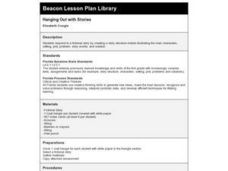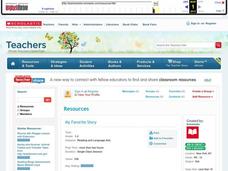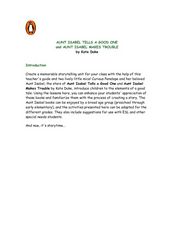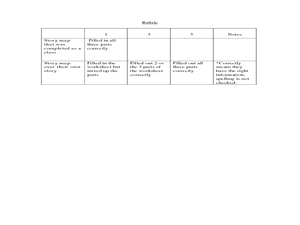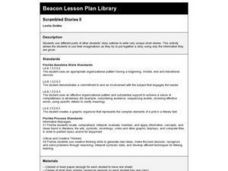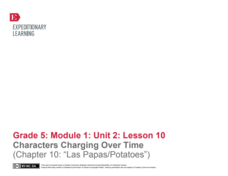Curated OER
How Characters Get What They Want
Sixth graders analyze the primary force that drives a character's actions in a character analysis lesson plan. In this character analysis lesson plan, 6th graders analyze how characters present their actions and participate in a group...
Curated OER
Reaching Your Potential - Personal Development
How do young people know the potential they possess? Middle schoolers explore their personal potential through two different activities and a class discussion. They examine where their aptitudes lie, and how they can use their gifts to...
Curated OER
Setting Goals with Benjamin Franklin
Students discuss historical accounts and accomplishments of "Benjamin Franklin" which exemplify good character traits. They create a display of paper keys which describe these traits. They relate these traits to their future goals and...
Curated OER
Responding to Literature
Your class will create a four section flip book and write titles for characters, setting, problem, and solution. They will also draw a picture to show what they wrote about.
Curated OER
Hanging Out with Stories
Help your class listen and respond to a fictional story by creating a story structure mobile illustrating the main characters, setting, plot, problem, story events, and solution. Using a coat hanger, they will create an artistic element...
Curated OER
My Favorite Story
Students discuss their favorite book. In this book discussion lesson plan, students name the title and tell what makes the book special. Students also review the setting, plot, conflict, and resolution. Students make a book that tells...
Curated OER
Out of the Dust: Background notes about the novel, The Great Depression, and The Dust Bowl
If your class is reading the historical fiction novel, Out of the Dust, then you are in luck. Here are a few slides that will help you provide historical context for the book, as well as define main characters, setting, symbolism, and...
Curated OER
What Makes a Novel a Novel?
They always say to write what you know. This approach is used to get middle schoolers prepared to write novels of their own. Using a favorite book as a model, potential novelists respond to prompts that ask about characters, plot, main...
Curated OER
Aunt Isabel Tells a Good One...
Explore language arts by reading two similar stories in order to compare and contrast them in class. Young readers read two Aunt Isabel books, by Kate Duke, and discuss the main characters, plot, and setting. They complete a graphic...
Curated OER
Fortune Cookies Motivate Writing
Fortune cookies are used as motivation for a story. In this creative writing lesson, young writers review the six traits process. They discuss interesting characters, setting, problem and solution in a story. Original stories based on...
Curated OER
Story Elements
Need a graphic organizer to help young readers list the events in a story? This worksheet includes the story title, author, setting, and characters split into four sections. Make charting story elements easy with this resource.
Curated OER
Dramatic Structure
As part of an lesson involving literature or writing, have your learners watch and discuss this presentation on plot development. In a series of slides, viewers engage in an activity to explore dramatic structure, including plot...
Curated OER
Make Up Your Story
Putting together an interesting story can be hard, but this set of worksheets will guide your writers into the depths of their own creativity as they characterize both their main character and villain. Using humor to keep learners...
Curated OER
Story Stew
Learners identify the elements of a story. For this reading and writing lesson, pupils read the book, Tyrone the Horrible by Hans Wihelm and then identify the characters, setting, and plot of the story.This lesson includes adaptations...
Curated OER
Scrambled Stories II
Review story elements with your class. They will use examples from a story to develop critical-thinking questions. Then they use a graphic organizer to describe the setting, character, and plot of the story, focusing on how they...
Curated OER
Big Pumpkin
Learners read a story and retell it through role playing. They will read Big Pumpkin, identify the main ideas and important characters, retell the story through dramatic play, and identify their favorite character.
Wuthering Heights
The Reader’s Guide to Emily Bronte's Wuthering Heights
Researching the characters, setting, and background history of a work of literature enhances interest and improves reading comprehension. An interactive website contains a wealth of resources related to Emily Bronte's novel Wuthering...
Curated OER
The News Behind the Story
What a fun way to analyze plot, setting, and character. Learners review story elements, read a short fictional story, then turn the events of that story into a headlining news paper article. Not only does this lesson plan engage critical...
Curated OER
Parts of a Narrative Poster Series
Your classroom won't be complete without a set of posters that can help learners hone in on the parts of a narrative story. Each of the six printable images is in full color and come with a definition and images that learners can use to...
EngageNY
Inferring About Characters Based on How They Respond to Challenges (Chapter 4: "Los Higos/Figs")
How do you know what a character's personality is like if an author doesn't tell you? With a focus on character development in Esperanza Rising, pupils complete a jigsaw activity to analyze the actions of Mama, Abuelita, and Miguel. Once...
Curated OER
Chatty Cherry Stories
Young artists will respond to reading children's literature, by engaging in original storytelling and representing their own images through the visual arts. Then they orally describe details of people, places, and things in their stories...
Prezi
Song of the Trees by Mildred Taylor
Explore the literary elements of Mildred Taylor's Song of the Trees with this beautiful Prezi presentation. Focusing on the story's characters, setting, and major plot points, young readers are provided with a complete summary of this...
EngageNY
Characters Changing Over Time (Chapter 10: "Las Papas/Potatos")
Engage further in Esperanza Rising with a focus on close reading and metaphor. Class members zero in on the tenth chapter, examining characters and big ideas. Pupils discuss the text in small groups and as a whole class, and participate...
Freeology
Annotations Bookmark
In general, pupils are not allowed to write in school-issued books; however, they can write on a bookmark that you provide! Kids can take notes on the setting, characters, themes, and connections as they read a short story or novel.






